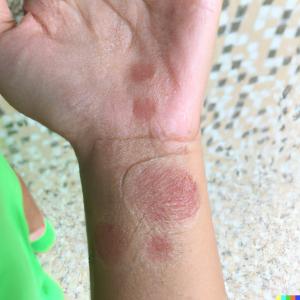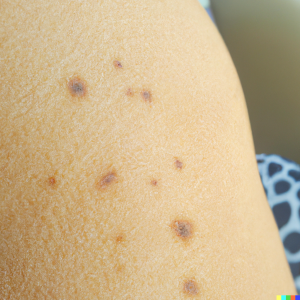
Ichthyosis is a group of rare skin disorders that are characterized by dry, scaly, and thickened skin that can lead to uncomfortable and sometimes disfiguring skin thickening. It is estimated to affect about one in every 500 to one in every 600 people worldwide. While there is no cure for ichthyosis, there are treatments and management options available to help improve the look and feel of affected skin.
Types of Ichthyosis
There are several different types of ichthyosis, each with its own set of symptoms and treatment options.
X-linked Ichthyosis (XLI)
X-linked ichthyosis, or XLI, is the most common type of ichthyosis, affecting one in 4,000 newborns. XLI is an inherited disorder caused by a mutation in the steroid sulfatase gene (STS) on the X chromosome. Symptoms include red, scaly patches that are usually concentrated on the scalp, elbows, and knees. The patches may be larger than normal and may flake off or form scales. Treatment includes the use of moisturizers, topical steroids, and retinoids to reduce scaling and redness.
Epidermolytic Ichthyosis (EI)
Epidermolytic ichthyosis, or EI, is a rare form of ichthyosis that is caused by a mutation in the keratin 1 (KRT1) or keratin 2 (KRT2) genes. It is characterized by red, scaly patches on the trunk, arms, and legs, but can also affect the face, ears, and scalp. The symptoms of EI are usually more severe than those of XLI and may include blister formation. Treatment typically involves the use of moisturizers, topical steroids, and retinoids to reduce scaling and redness.
Lamellar Ichthyosis (LI)
Lamellar ichthyosis, or LI, is a rare form of ichthyosis caused by a mutation in the transglutaminase 1 (TGM1) gene. Symptoms include scaly, reddish-brown patches on the body and sometimes the face. The patches can often be creamy in color and may appear raised or waxy. Treatment options include the use of moisturizers and topical steroids to reduce scaling and redness.
Congenital Ichthyosiform Erythroderma (CIE)
Congenital ichthyosiform erythroderma, or CIE, is a rare form of ichthyosis caused by a mutation in the transglutaminase 1 (TGM1) gene. Symptoms include thick, red, scaly patches that can cover the entire body. The patches can often be itchy and may cause skin irritation. Treatment typically involves the use of moisturizers, topical steroids, and retinoids to reduce scaling and redness.
Harlequin Ichthyosis (HI)
Harlequin ichthyosis, or HI, is a rare and very severe form of ichthyosis caused by a mutation in the ABCA12 gene. Symptoms include thick, red, scaly patches that may be diamond-shaped and can be found on the face, neck, chest, and limbs. The patches can be very uncomfortable and may be prone to cracking. Treatment involves the use of moisturizers, topical steroids, and retinoids to reduce scaling and redness, as well as antibiotics to prevent secondary infections.
Ichthyosis Vulgaris (IV)
Ichthyosis vulgaris, or IV, is the most common inherited form of ichthyosis and affects one in 250 people. It is caused by a mutation in the filaggrin gene and is characterized by dry, scaly patches on the skin that are usually confined to the arms, legs, and torso. Treatment typically involves the use of moisturizers and topical steroids to reduce scaling and redness.
Causes of Ichthyosis
Genetics is one of the most common causes of Ichthyosis. In many cases, it is an inherited disorder that is passed down from parents to children. The exact genetic cause of Ichthyosis is not yet known, but it is believed to involve certain changes in the skin’s cells that prevent them from producing enough moisture. Mutations in certain genes have been linked to increased risk of Ichthyosis.
Environmental factors can also play a role in the development of Ichthyosis. Exposure to certain chemicals, such as pesticides and solvents, can increase an individual’s risk of developing the condition. In addition, exposure to extreme temperatures, such as very hot or very cold, can also contribute to the development of the disorder.
Although the exact cause of Ichthyosis is not yet known, there are certain medical conditions that have been linked to the condition. Certain types of diabetes, autoimmune disorders, and liver disease can all increase an individual’s risk of developing Ichthyosis. In addition, certain medications, such as those used to treat high blood pressure and cholesterol, can also increase the risk of developing the condition.
Stress is another possible cause of Ichthyosis. Stress can cause changes in the skin’s cells, which can lead to dry, scaly patches. It is thought that high levels of stress can increase the likelihood of developing Ichthyosis.
Certain lifestyle factors can also contribute to the development of Ichthyosis. For example, if an individual’s skin is exposed to excessive sun exposure or frequent swimming in chlorinated pools, it may increase their risk of developing the condition. In addition, if an individual has a poor diet or is not getting enough rest, it can also increase their risk of developing the condition.

Symptoms of Ichthyosis
The most common symptom of ichthyosis is dry, scaly skin. The skin can become rough, thickened, and may appear reddish-brown. In severe cases, the skin can become cracked, crumbly, and itchy. Lesions may develop, and the skin can become hard and leathery. In some cases, the skin may become very itchy due to severe dryness.
The skin may also become thickened and may form large, dark-colored scales. These scales can be small and hard or large and flaky. They may also form in patterns or clusters. The scales may be yellowish, brownish, or grayish in color. They can be uncomfortable and may cause pruritus (itchiness).
In some cases, ichthyosis may cause an inflammatory response in the skin, resulting in redness, swelling, and pain. Blisters may also form and the skin may become raw and tender. In more severe cases, blisters may leak fluid and form crusts. The skin may also crack and bleed.
Ichthyosis may also cause hair loss. The hair loss may be patchy or more general and may cause the affected areas to look bald. The scalp may also become dry, scaly and flaky. In some cases, the scalp may become inflamed, causing redness and pain.
In addition to the skin and scalp, ichthyosis may cause thickening of the nails. The nails may become brittle and split or form ridges. In severe cases, the nails may become yellowish or white and may detach from the nail bed.
Ichthyosis may also cause other symptoms such as eye irritation, redness, and pain. In some cases, the eyes may become dry and gritty, and the eyelids may become thickened and scaled. Other symptoms may include hoarseness, difficulty breathing, and fatigue.
Prevention and Treatment of Ichthyosis
The first step in preventing and treating Ichthyosis is to protect the skin. This includes wearing appropriate clothing, such as lightweight, non-irritating fabrics, and avoiding tight-fitting clothing. It is also important to moisturize the skin daily to help retain moisture and keep it hydrated. Applying sunscreen before going outdoors can also help protect the skin from sun damage.
It is also important to avoid environmental triggers that can worsen Ichthyosis. Common triggers include rough materials, heat, and humidity. When possible, it is best to avoid activities that will cause the skin to become overheated or too dry. Additionally, it is important to avoid contact with harsh chemicals, such as detergents, soaps, and perfumes, as these can irritate the skin.
A variety of treatments are available for Ichthyosis. Topical creams, such as those containing urea, lactic acid, or salicylic acid, can help to soften and exfoliate the skin. Moisturizers can also be beneficial as they help to keep the skin hydrated and reduce irritation. In some cases, oral medications, such as antibiotics or systemic retinoids, may be prescribed to help reduce inflammation and reduce the effects of the disorder.
Laser therapy is another option for treating Ichthyosis. Laser therapy is a non-invasive treatment that uses light energy to stimulate collagen production, helping to reduce the appearance of scaly patches. Laser treatments are typically done in a medical office and may require multiple treatments over a period of time to achieve optimal results.
Phototherapy is a type of treatment that uses ultraviolet light to reduce scaling and inflammation. Phototherapy is typically done in a doctor’s office and can provide significant improvements in the appearance of the skin.